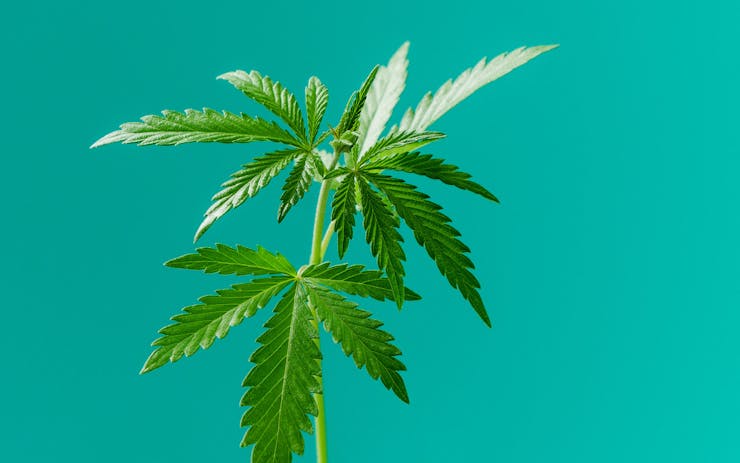CBDA (cannabidiolic acid) is one of many compounds produced by cannabis and hemp. Abundant in the live plants of CBD varieties, it converts to the better known cannabinoid CBD (cannabidiol) over time and when exposed to heat.
Cannabinoids are cannabis compounds that interact with our bodies to produce medical and recreational effects, from pain and stress relief to euphoria. You’ve likely heard of CBD and THC—these are the most widely known cannabinoids, and both originally stem from the precursor “mothership” cannabinoid known as CBGA (cannabigerolic acid).
CBGA converts to three major cannabinoid precursor compounds, depending on which plant enzymes are activated to direct the synthesis:
- THCA (tetrahydrocannabinolic acid)
- CBCA (cannabichromenic acid)
- CBDA (cannabidiolic acid).
When decarboxylation occurs by exposing the cannabis plant to either heat or sunlight, CBDA converts to CBD. In other words, CBDA is the raw form or predecessor to CBD.
These days, CBDA is typically found in capsules, tinctures, and topicals. Many people even juice raw cannabis to get a daily dose of CBDA.
But what does CBDA do and why is it important?
Potential Medical Benefits of CBDA
While most cannabinoids bind directly with either the CB1 or CB2 receptors, CBDA doesn’t work in this way. Instead, CBDA interacts with the endocannabinoid system by inhibiting the cyclooxygenase-2 (COX-2) enzyme. COX-2 enzymes are associated with inflammation after an injury or infection, so by blocking COX-2 enzymes, CBDA can relieve inflammation and associated pain.
In one rodent study, scientists found CBDA affected levels of serotonin, a chemical produced by nerve cells to aid in signaling between cells. Serotonin is vital to core human functions like motor skills, sleeping, eating, digestion, and emotions.
Shop highly rated dispensaries near you
Showing you dispensaries nearA number of stressors, including radiation and chemotherapy, trigger the body to release excess serotonin, causing nausea and vomiting. While vomiting can typically be controlled with medication, nausea is harder to control. Many cancer patients say that nausea causes much more distress than vomiting because nausea is a continuous sensation. In fact, one in five patients consider discontinuing cancer treatment so as to not experience the nausea.
Scientists have demonstrated that CBDA can affect the body’s 5-HT serotonin-producing receptors, hinting at a potential use for CBDA as a medication for chemotherapy-induced nausea/vomiting (CINV) and other conditions that induce these symptoms. However, more research is needed.
The Current Research on CBDA
Scientists have been studying CBDA for about a decade.
An early 2008 study looked at the potential of CBDA as an anti-inflammatory agent by specifically studying its COX-2 inhibitor qualities. The research team compared the molecular structures of CBDA with nonsteroidal anti-inflammatory drugs (NSAIDs) commonly used to treat inflammation and found their chemical structures remarkably similar; both are known to inhibit COX-2 receptors. This initial study showed that CBDA holds promise as a potential anti-inflammatory agent.
In the same way that it controls nausea, CBDA may also be a powerful anticonvulsive. In fact, scientists have shown that CBDA has 100 times the affinity for the 5-HT receptors compared to CBD; one reason is that CBDA has greater bioavailability, so the body can metabolize the compound with less effort and in less time.
This same receptor affinity could also mean that CBDA could perhaps effectively fight depression. After all, CBDA works on the 5-HT receptors in much the same way as a selective serotonin reuptake inhibitor (SSRI) antidepressant medication would.
To date, most CBDA studies are preclinical non-human studies. While human trials are needed, some medical cannabis companies like British-based GW Pharmaceuticals are paving the way. GW Pharmaceuticals manufactures a pharmaceutical-grade CBD oil called Epidiolex, the first cannabis-derived prescription drug to be approved by the US Food and Drug Administration (FDA).
Interestingly, the FDA required the company to not only conduct CBD research, but to also conduct research on the precursor CBDA, and GW’s own research shows that CBDA is an even more effective seizure treatment. The company has also filed two other CBDA medical-use patents: one for inflammatory skin diseases and the other for cancer treatment.
Although CBDA cancer research to date has only been on isolated cells, initial studies indicate that CBDA might stop the migration of a highly aggressive form of breast cancer cell known as MDA-MB-231.





